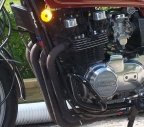Carburetor Diaphragm Repair
- mkeating
-
Topic Author
- Offline
- User
-

Registered
- Posts: 10
- Thanks: 0
Carburetor Diaphragm Repair
11 Aug 2009 10:39
Just wondering if anyone can tell me if it is possible to repair tiny holes in your carb diaphragm. I have a 1981 440 ltd, chain driven. I have come across a site where you can purchase replacement diaphragms, along with provided instructions.
www.motorradbay.de/main/kawa.php?main=membran
the installation instructions are located:
www.motorradbay.de/main/images/pro/Libranenanleitung.pdf
Just wondering if anyone has tried this, or if anyone knows where I can get some reasonably priced replacements, or even if they can be patched?
How much would a couple of tiny holes affect the performance. I have been having real problems starting the bike because the carbs seem to flood themselves while sitting. I am assuming this could be the cause?? THanks
the installation instructions are located:
www.motorradbay.de/main/images/pro/Libranenanleitung.pdf
Just wondering if anyone has tried this, or if anyone knows where I can get some reasonably priced replacements, or even if they can be patched?
How much would a couple of tiny holes affect the performance. I have been having real problems starting the bike because the carbs seem to flood themselves while sitting. I am assuming this could be the cause?? THanks
Please Log in or Create an account to join the conversation.
- mkeating
-
Topic Author
- Offline
- User
-

Registered
- Posts: 10
- Thanks: 0
Please Log in or Create an account to join the conversation.
- Mcdroid
-

- Offline
- User
-

Registered
- Gone Kwackers
- Posts: 6775
- Thanks: 417
Re: Carburetor Diaphragm Repair
11 Aug 2009 11:12
Contact George Lesho at
www.wgcarbs.com
. You'll have to join his site to post a question (but it's free). George does have the ability to patch diaphragms.
Michael
Victoria, Texas
1982 GPz750
1977 KZ1000A
1978 KZ1000A
1982 GPz1100
1975 Z2A
Victoria, Texas
1982 GPz750
1977 KZ1000A
1978 KZ1000A
1982 GPz1100
1975 Z2A
Please Log in or Create an account to join the conversation.
- JR
-

- Offline
- Sustaining Member
-

Registered
- Posts: 2960
- Thanks: 474
Re: Carburetor Diaphragm Repair
11 Aug 2009 11:36 - 11 Aug 2009 11:37
Interesting website and the instructions seem straightforward. Not cheap if thats the price per diaphragm.
I have read that it is possible to make a repair using the liquid plastic coating used for dipping tool handles. I have seen it at the local hardware store but cant remember what the name of the product is. You place a piece of graseproof paper behind the hole a paint a dab over the hole. When the stuff has set you remove the paper and do the other side.
I have never done this, just read about it so cant say of it really works or whether temporary or permanent.
Good Luck
I have read that it is possible to make a repair using the liquid plastic coating used for dipping tool handles. I have seen it at the local hardware store but cant remember what the name of the product is. You place a piece of graseproof paper behind the hole a paint a dab over the hole. When the stuff has set you remove the paper and do the other side.
I have never done this, just read about it so cant say of it really works or whether temporary or permanent.
Good Luck
1980 kz750E1, Delkevic exhaust
Last edit: 11 Aug 2009 11:37 by JR.
Please Log in or Create an account to join the conversation.
- MFolks
-

- Offline
- User
-

Registered
- Posts: 6650
- Thanks: 541
Re: Carburetor Diaphragm Repair
11 Aug 2009 11:37
Here's something I found regarding diaphram repair of carbs:
Carburetor diaphragm repair that works.
Ok so your old bike's carb diaphragm has a little pinhole in it, or you've got a little tear like mine does from being old and maybe a backfire or something. So you go to the dealership or check online and you can't find a replacement anywhere. You may stumble upon services that will re-diaphragm any old carb slide, but the wait time is a month and you can't afford the 170 bucks a piece. Never fear, I have found a solution.
Carb diaphragms are made of nitrile rubber and so are nitrile gloves (big surprise right) so I experimented on several gloves with various adhesives that I thought might work and eventually I found one.
First up was liquid electrical tape. The liquid electrical tape bonded the glove together really quick and held pretty damn strong. Much stronger than needed for a diaphragm. I then tested its resistance to Gum-out (which you should NEVER use on CV diaphragm carbs btw!) and the gumout dissolved it quick. Gumout also slackened and ate through the gloves after several minutes. Well scratch that one, I wanted something that would stand up to gasoline and the occaisional capful of cleaner.
Next up, weather stripping adhesive. This was a good candidate because it seems to hold soft rubber very well for nearly forever. Same problem as the liquid electrical tape. They both smell similar as well which might indicate the solvent being usedm which is easily cut with gumout. I would imagine that xylene and lacquer thinners would have the same effect. I know after painting with nitrile gloves (urethanes, lacquers, clear coats) that the gloves are resistant but will eventually break down anyway. This reinforces the NEVER USE CARB CLEANER SPRAY IN A CV CARB advice.
On the third try, and after reading some industrial adhesives literature, I came across a family of adhesives that include regular super glue, and polyurethane adhesives. You may know the polyurethane adhesives under "Gorilla Glue" or Elmer's "Probond". These guys have di-isocyanates in them and can be particularly nasty, but cyanoacrylates and di-isocyanates are one of the only suitable bonding materials for nitrile rubber, or even hydrogenated n butyl rubbers (the green o rings used in r134 ac systems). And speaking of HNBR (the green rubber), I wish people would push keihn and mikuni and the like to use that stuff in carbs. When you look at what they resist and the temps and pressures they resist, they are CLEARLY the choice for using in a nasty gasoline / solvent environment especially where there is heat involved.... But I digress. So gorilla glue is your best bet. Superglue cures too stiff, and will degrade over time with humidity (crazy huh?). The gorilla glue, being a polyurethane and using the chemicals it does to react with the bonded surfaces, won't let go even when covered with gasoline or carb cleaner. It remains somewhat flexible, but of course is much stiffer than your diaphragm which is just a nitrile rubber coated cloth. You can apply it thinly over tears and cracks and holes and it's not going to let go.
Alternately, some people say that the spray tool dip available from napa auto parts works like a charm. The only problem here is you are increasing the thickness of the diaphragm and that will decrease the response rate of the slide. It's not that big of a deal to get by but still... The main concern is keeping the hole closed #1, and keeping it airtight #2. You could always use a small bead of gorilla glue to hold a tear closed and spray rubber over it for added protection. You could even gorilla glue some nitrile rubber glove over a larger tear. But as I said, response rate will be affected. If you think about it though, there are big springs which hold the slide down, and the suction is really what makes them rise, so as long as they still slide up and down relatively well, and are sealed you should be fine.
The bottom line is, this fix will cost you under 10 bucks and get you going in 24 hours. While you ride on it, look for a new diaphragm, or better yet, save up some money for a set of VMs or something that doesn't use those ?!!&# diaphragms!
.
Carburetor diaphragm repair that works.
Ok so your old bike's carb diaphragm has a little pinhole in it, or you've got a little tear like mine does from being old and maybe a backfire or something. So you go to the dealership or check online and you can't find a replacement anywhere. You may stumble upon services that will re-diaphragm any old carb slide, but the wait time is a month and you can't afford the 170 bucks a piece. Never fear, I have found a solution.
Carb diaphragms are made of nitrile rubber and so are nitrile gloves (big surprise right) so I experimented on several gloves with various adhesives that I thought might work and eventually I found one.
First up was liquid electrical tape. The liquid electrical tape bonded the glove together really quick and held pretty damn strong. Much stronger than needed for a diaphragm. I then tested its resistance to Gum-out (which you should NEVER use on CV diaphragm carbs btw!) and the gumout dissolved it quick. Gumout also slackened and ate through the gloves after several minutes. Well scratch that one, I wanted something that would stand up to gasoline and the occaisional capful of cleaner.
Next up, weather stripping adhesive. This was a good candidate because it seems to hold soft rubber very well for nearly forever. Same problem as the liquid electrical tape. They both smell similar as well which might indicate the solvent being usedm which is easily cut with gumout. I would imagine that xylene and lacquer thinners would have the same effect. I know after painting with nitrile gloves (urethanes, lacquers, clear coats) that the gloves are resistant but will eventually break down anyway. This reinforces the NEVER USE CARB CLEANER SPRAY IN A CV CARB advice.
On the third try, and after reading some industrial adhesives literature, I came across a family of adhesives that include regular super glue, and polyurethane adhesives. You may know the polyurethane adhesives under "Gorilla Glue" or Elmer's "Probond". These guys have di-isocyanates in them and can be particularly nasty, but cyanoacrylates and di-isocyanates are one of the only suitable bonding materials for nitrile rubber, or even hydrogenated n butyl rubbers (the green o rings used in r134 ac systems). And speaking of HNBR (the green rubber), I wish people would push keihn and mikuni and the like to use that stuff in carbs. When you look at what they resist and the temps and pressures they resist, they are CLEARLY the choice for using in a nasty gasoline / solvent environment especially where there is heat involved.... But I digress. So gorilla glue is your best bet. Superglue cures too stiff, and will degrade over time with humidity (crazy huh?). The gorilla glue, being a polyurethane and using the chemicals it does to react with the bonded surfaces, won't let go even when covered with gasoline or carb cleaner. It remains somewhat flexible, but of course is much stiffer than your diaphragm which is just a nitrile rubber coated cloth. You can apply it thinly over tears and cracks and holes and it's not going to let go.
Alternately, some people say that the spray tool dip available from napa auto parts works like a charm. The only problem here is you are increasing the thickness of the diaphragm and that will decrease the response rate of the slide. It's not that big of a deal to get by but still... The main concern is keeping the hole closed #1, and keeping it airtight #2. You could always use a small bead of gorilla glue to hold a tear closed and spray rubber over it for added protection. You could even gorilla glue some nitrile rubber glove over a larger tear. But as I said, response rate will be affected. If you think about it though, there are big springs which hold the slide down, and the suction is really what makes them rise, so as long as they still slide up and down relatively well, and are sealed you should be fine.
The bottom line is, this fix will cost you under 10 bucks and get you going in 24 hours. While you ride on it, look for a new diaphragm, or better yet, save up some money for a set of VMs or something that doesn't use those ?!!&# diaphragms!
.
1982 GPZ1100 B2
General Dynamics/Convair 1983-1993
GLCM BGM-109 Tomahawk, AGM-129A Advanced Cruise Missile (ACM)
General Dynamics/Convair 1983-1993
GLCM BGM-109 Tomahawk, AGM-129A Advanced Cruise Missile (ACM)
Please Log in or Create an account to join the conversation.
- bountyhunter
-

- Offline
- User
-

Registered
- Posts: 7245
- Thanks: 338
Re: Carburetor Diaphragm Repair
11 Aug 2009 17:02 - 11 Aug 2009 17:03
I actually used the "permabond" urethane type glue on the slits in my diaphragms, the specific brand was "Elmer's Ultimate" glue.
It actually worked, but you need to take a Q tip with acetone and lightly clean the area the glue must bond to. I used a toothpick to work glue through the dia hole then put a bit on either side. It ran about a month until my new ones arrived, and it worked very well (was still holding well).
It actually worked, but you need to take a Q tip with acetone and lightly clean the area the glue must bond to. I used a toothpick to work glue through the dia hole then put a bit on either side. It ran about a month until my new ones arrived, and it worked very well (was still holding well).
1979 KZ-750 Twin
Last edit: 11 Aug 2009 17:03 by bountyhunter.
Please Log in or Create an account to join the conversation.
- bountyhunter
-

- Offline
- User
-

Registered
- Posts: 7245
- Thanks: 338
Re: Carburetor Diaphragm Repair
11 Aug 2009 17:06
mkeating wrote:
More than you would believe. It keeps the slides from rising at small throttle openings giving poor throttle response.How much would a couple of tiny holes affect the performance.
1979 KZ-750 Twin
Please Log in or Create an account to join the conversation.
- otakar
-

- Offline
- User
-

Registered
- Posts: 5073
- Thanks: 29
Re: Carburetor Diaphragm Repair
11 Aug 2009 17:16
bountyhunter wrote:
Actually the slides do not start opening until the throttle is about a quarter open so a tiny pinhole will not do much damage. I have fixed a few slides and I use a piece of silk and the liquid electrical tape. This is a very flexible and permanent fix. Just make sure that the adhesive is put on very thinly, and you overlap the damaged area by no more than 1/8" with the silk and adhesive.
mkeating wrote:More than you would believe. It keeps the slides from rising at small throttle openings giving poor throttle response.How much would a couple of tiny holes affect the performance.
Actually the slides do not start opening until the throttle is about a quarter open so a tiny pinhole will not do much damage. I have fixed a few slides and I use a piece of silk and the liquid electrical tape. This is a very flexible and permanent fix. Just make sure that the adhesive is put on very thinly, and you overlap the damaged area by no more than 1/8" with the silk and adhesive.
74 Z1-A stock
76 KZ-900 Totaly stock vice MAC pipe
77 KZ-1000A stock
78 Z1-R 100%MINT 500 original Mi.
78 Z1-R Yoshi 1103 kit stage 1 cams Yoshi pipe. Etc
79 KZ-1300 (1400)
80 KZ-1300
81 Scratch built GPz1150R
82 KZ1000
76 KZ-900 Totaly stock vice MAC pipe
77 KZ-1000A stock
78 Z1-R 100%MINT 500 original Mi.
78 Z1-R Yoshi 1103 kit stage 1 cams Yoshi pipe. Etc
79 KZ-1300 (1400)
80 KZ-1300
81 Scratch built GPz1150R
82 KZ1000
Please Log in or Create an account to join the conversation.
- JMKZHI
-

- Offline
- Platinum Member
-

Registered
- Posts: 2428
- Thanks: 48
Re: Carburetor Diaphragm Repair
11 Aug 2009 19:57
Someone on ebbaayy sells diaphragm rubbers.
A how-to w pics is included in the item description.
Search there for KZ440 diaphragm rubber.
A how-to w pics is included in the item description.
Search there for KZ440 diaphragm rubber.
Please Log in or Create an account to join the conversation.
- bountyhunter
-

- Offline
- User
-

Registered
- Posts: 7245
- Thanks: 338
Re: Carburetor Diaphragm Repair
11 Aug 2009 22:15
otakar wrote:
I guess it depends on what we call a small hole. Mine each had a couple of tiny slits maybe 1/4" long and were giving really bad throttle response. I had to compensate with larger pilot jets and moving the needle to get it rideable. Once I plugged the slits, it ran normal again. Amazing how long I screwed with the carbs before I found those little slits in the "lace curtains" near the rim of the rubbers.bountyhunter wrote:mkeating wrote:More than you would believe. It keeps the slides from rising at small throttle openings giving poor throttle response.How much would a couple of tiny holes affect the performance.
Actually the slides do not start opening until the throttle is about a quarter open so a tiny pinhole will not do much damage.
1979 KZ-750 Twin
Please Log in or Create an account to join the conversation.
- mkeating
-
Topic Author
- Offline
- User
-

Registered
- Posts: 10
- Thanks: 0
Re: Carburetor Diaphragm Repair
12 Aug 2009 04:00
Everyone,
Thanks so much for all your responses. I have quite a bit of information here I think I can go with. Does anyone know where you can buy the grease paper that the adhesive will not stick so that you can plug the hole while you spray it?? I think I am going to temporarily fix the hole with the spray on rubber you can buy at NAPA. I have read a few stories of people using this and it seems to work well on almost everything, inluding carb boots, etc... I will also take a look on ebay to see what I can find. If anyone else can think of anything else let me know. Your comments are always appreciated. Cheers!!
Thanks so much for all your responses. I have quite a bit of information here I think I can go with. Does anyone know where you can buy the grease paper that the adhesive will not stick so that you can plug the hole while you spray it?? I think I am going to temporarily fix the hole with the spray on rubber you can buy at NAPA. I have read a few stories of people using this and it seems to work well on almost everything, inluding carb boots, etc... I will also take a look on ebay to see what I can find. If anyone else can think of anything else let me know. Your comments are always appreciated. Cheers!!
Please Log in or Create an account to join the conversation.
- OKC_Kent
-

- Offline
- User
-

Registered
- Posts: 1719
- Thanks: 21
Re: Carburetor Diaphragm Repair
12 Aug 2009 05:13
I never heard of grease paper, unless they mean "wax paper"
Cashion, OK
78 KZ650 B2 85,000+ miles
78 KZ650 B2 85,000+ miles
Please Log in or Create an account to join the conversation.
Moderators: Street Fighter LTD
